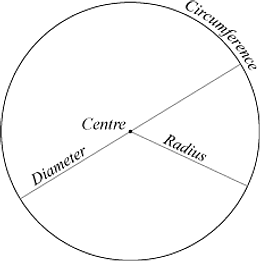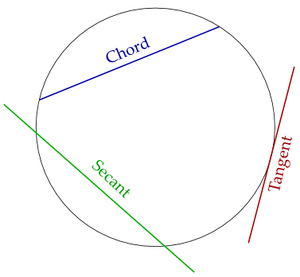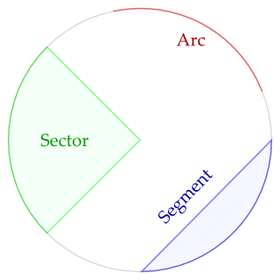Circle
- See The Circle for the distributed file storage system, and see Ring (diacritic) for the diacritic mark.

In Euclidean geometry, a circle is the set of all points in a plane at a fixed distance, called the radius, from a fixed point, called the centre. Circles are simple closed curves, dividing the plane into an interior and exterior. Sometimes the word circle is used to mean the interior, with the circle itself called the circumference. Usually however, the circumference means the length of the circle, and the interior of the circle is called a disk or disc.
Mathematical definitions
In an x-y coordinate system, the circle with centre (x0, y0) and radius r is the set of all points (x, y) such that
If the circle is centered at the origin (0, 0), then this formula can be simplified to
The circle centered at the origin with radius 1 is called the unit circle.
Expressed in polar coordinates, (x,y) can be written as
- x = x0 + r·cos(φ)
- y = y0 + r·sin(φ).
The slope (or derivate) of a circle can be expressed with the following formula:
All circles are similar; as a consequence, a circle's circumference and radius are proportional, as are its area and the square of its radius. The constants of proportionality are 2π and π, respectively. In other words:
- Length of a circle's circumference =
- Area of a circle =
The formula for the area of a circle can be derived from the formula for the circumference and the formula for the area of a triangle, as follows. Imagine a regular hexagon (six-sided figure) divided into equal triangles, with their apices at the center of the hexagon. The area of the hexagon may be found by the formula for triangle area by adding up the lengths of all the triangle bases (on the exterior of the hexagon), multiplying by the height of the triangles (distance from the middle of the base to the center) and dividing by two. This is an approximation of the area of a circle. Then imagine the same exercise with an octagon (eight-sided figure), and the approximation is a little closer to the area of a circle. As a regular polygon with more and more sides is divided into triangles and the area calculated from this, the area becomes closer and closer to the area of a circle. In the limit, the sum of the bases approaches the circumference 2πr, and the triangles' height approaches the radius r. Multiplying the circumference and radius and dividing by 2, we get the area, π r².
Properties


A line cutting a circle in two places is called a secant, and a line touching the circle in one place is called a tangent. The tangent lines are necessarily perpendicular to the radii, segments connecting the centre to a point on the circle, whose length matches the definition given above. The segment of a secant bound by the circle is called a chord, and the longest chords are those that pass through the centre, called diameters and divided into two radii. The area of a circle cut off by a chord is called a circle segment.
It is possible (Circle points segments proof) to find the maximum number of unique segments generated by running chords between a number of points on the perimeter of a circle.
If only (part of) a circle is known, then the circle's center can be constructed as follows: take two non-parallel chords, construct perpendicular lines on their midpoints, and find the intersection point of those lines. The radius for such a partial circle may be calculated from the length L of a chord, and the distance D from the center of the chord to the nearest point on the circle by various formulas including: (from a geometric derivation)
(from a trigonometric derivation)
A part of the circumference bound by two radii is called an arc, and the area (i.e., the slice of the disk) within the radii and the arc is a sector. The ratio between the length of an arc and the radius defines the angle between the two radii in radians.
Every triangle gives rise to several circles: its circumcircle containing all three vertices, its incircle lying inside the triangle and touching all three sides, the three excircles lying outside the triangle and touching one side and the extensions of the other two, and its nine point circle which contains various important points of the triangle. Thales' theorem states that if the three vertices of a triangle lie on a given circle with one side of the triangle being a diameter of the circle, then the angle opposite to that side is a right angle.
Given any three points which do not lie on a line, there exists precisely one circle whose boundary contains those points (namely the circumcircle of the triangle defined by the points). Given three particular points <(x1,y1), (x2,y2), (x3,y3)>, the equation of this circle is given in a simple way by this equation using the matrix determinant:
A circle is a kind of conic section, with eccentricity zero. In affine geometry all circles and ellipses become (affinely) isomorphic, and in projective geometry the other conic sections join them. In topology all simple closed curves are homeomorphic to circles, and the word circle is often applied to them as a result. The 3-dimensional analog of the circle is the sphere.
Squaring the circle refers to the (impossible) task of constructing, for a given circle, a square of equal area with ruler and compass alone. Tarski's circle-squaring problem, by contrast, is the task of dividing a given circle into finitely many pieces and reassembling those pieces to obtain a square of equal area. Assuming the axiom of choice, this is indeed possible.
Three-dimensional shapes whose cross-sections in some planes are circles include spheres, spheroids, cylinders, and cones.
See also
External links
- Clifford's Circle Chain Theorems. This is a step by step presentation of the first theorem. Clifford discovered, in the ordinary Euclidean plane, a "sequence or chain of theorems" of increasing complexity, each building on the last in a natural progression. by Antonio Gutierrez from "Geometry Step by Step from the Land of the Incas"








